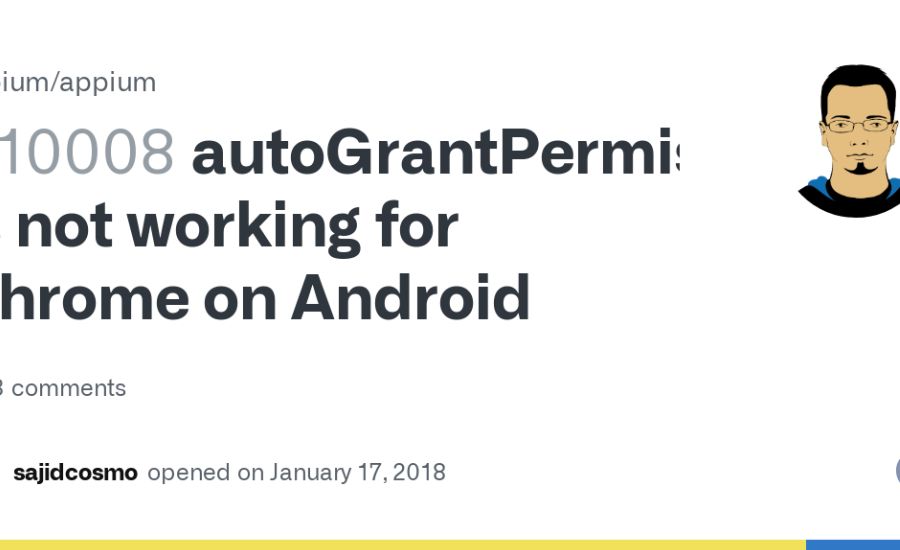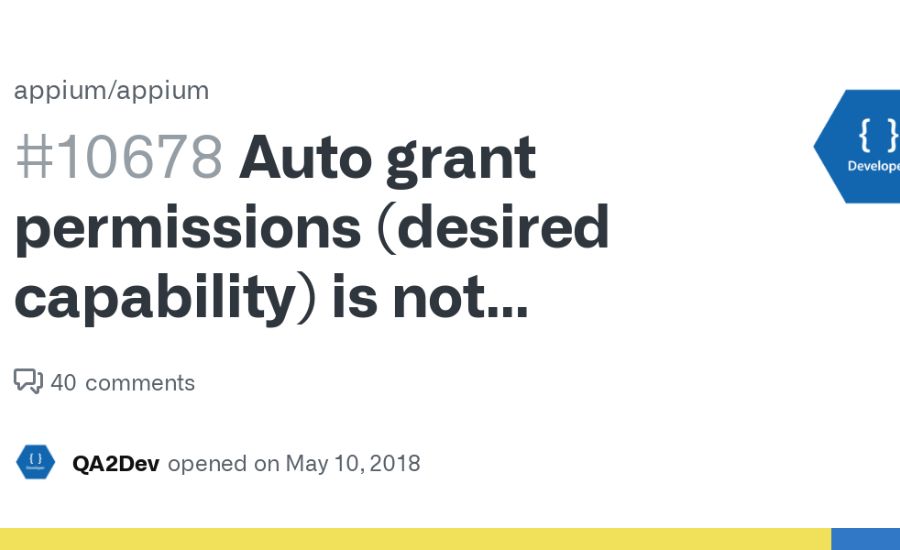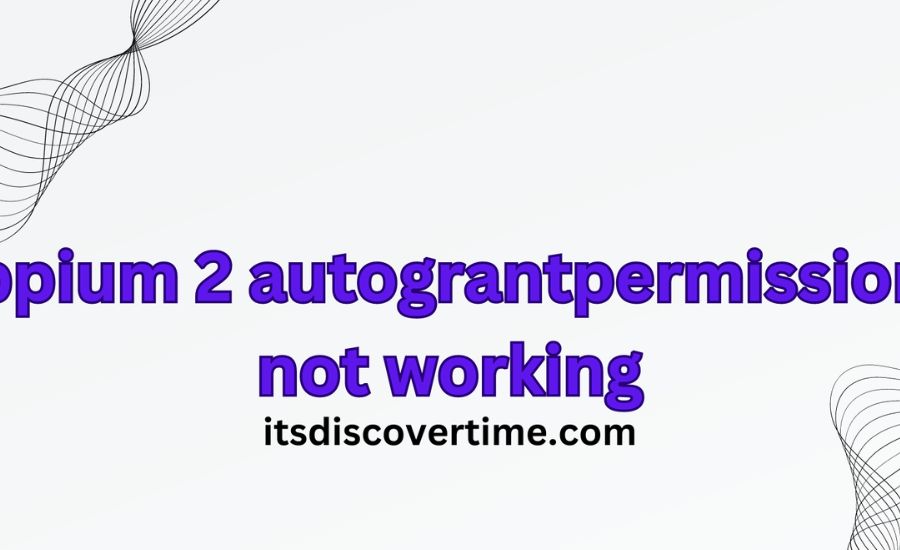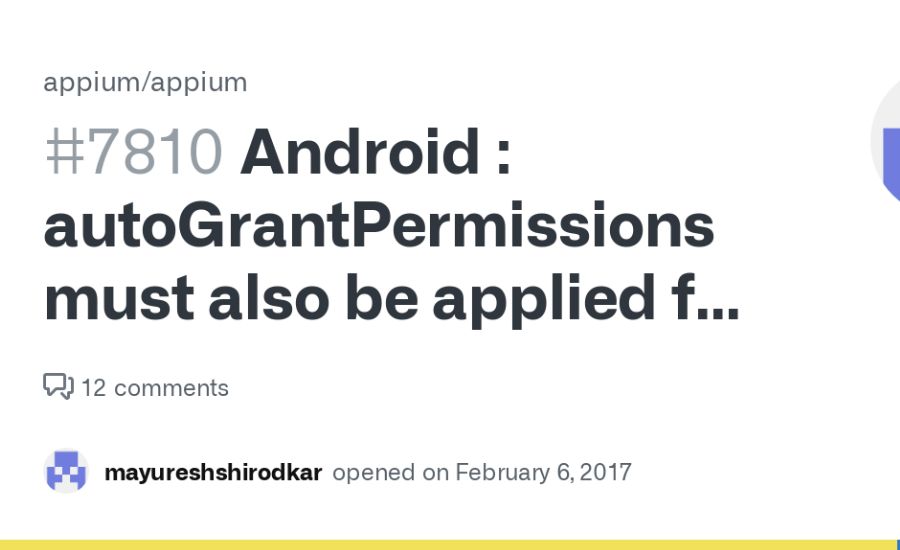Appium 2 AutoGrantPermissions Not Working, Feature, Version & More
Introduction to Appium 2 AutoGrantPermissions Not Working

Appium 2 is a well known open-source device utilized for computerizing versatile applications, and its most recent variant accompanies a scope of cutting edge highlights intended to further develop client experience and adaptability. One of the champion elements of Appium 2 is autoGrantPermissions. This element means to improve on the testing system via consequently giving every one of the authorizations that an application demands in its manifest record. Regardless of this promising usefulness, a few clients have detailed that autoGrantPermissions doesn’t necessarily function as expected.
Handling Permission Pop-Ups During Testing
While running computerized tests on versatile applications, it’s generally expected to experience different pop-ups or frameworks that request authorizations, like admittance to contacts, warnings, or photographs. Actually dealing with these consent demands is essential for the smooth execution of tests. The following are a couple of methodologies to deal with these collaborations:
Pre-Test Design: Prior to running tests, arrange your test climate to give vital consents. This should frequently be possible through gadget settings or design documents.
Utilize Appium’s Inherent Capacities: Past autoGrantPermissions, investigate other Appium abilities and settings that could assist with overseeing consents during testing. This incorporates utilizing the desiredCapabilities to set authorizations physically in the event that programmed taking care of falls flat.
Custom Contents: Compose custom contents to deal with consent discoursed. These contents can collaborate with the UI components of the exchange boxes to give authorizations depending on the situation.
Testing Structure Incorporation: Coordinate your testing system with apparatuses or libraries that give better command over framework exchanges and pop-ups, further developing how your tests handle consent demands.
Gadget Explicit Arrangements: Think about gadget explicit arrangements or settings. Various gadgets and working frameworks might require fitted ways to deal with handling authorizations successfully.
Importance of the AutoGrantPermissions Feature

Guaranteeing that versatile applications have the vital consents is essential for exhaustive testing. Nonetheless, physically dealing with these consents can frequently be a drawn-out and blunder inclined task. That is where Appium 2’s autoGrantPermissions highlight comes in.
Intended to make the testing system smoother, autoGrantPermissions consequently concedes every one of the consents an application needs when it’s sent off. This lifts testing proficiency as well as limits the gamble of human mistake, making your testing interaction more dependable and smoothed out.
With this component, you can zero in addition on what makes a difference — approving your application’s usefulness — as opposed to getting hindered by consent related issues.
Common Challenges with AutoGrantPermissions and How to Address Them
Identifying Problems with AutoGrantPermissions

While the autoGrantPermissions highlight in Appium 2 is intended to smooth out the authorization cycle, it’s not like a well-oiled machine. Sometimes, you could find that it doesn’t fill in true to form, which can intrude on your computerized tests and require manual fixes. Here is a typical issue and how to address it:
Incorrect Capability Configuration
Issue: Frequently, issues with autoGrantPermissions originate from misconfigured settings in the ideal capacities. On the off chance that this component isn’t working as expected, it may very well be because of a basic error by the way it’s set up.
Solution:Twofold check that the autoGrantPermissions capacity is accurately included and precisely spelled in your Appium 2 content. A little grammatical error or misconfiguration can prompt the element not working accurately.
Example Configuration:
json
Duplicate code
{
“platformName”: “Android”,
“deviceName”: “emulator-5554”,
“application”: “/way/to/your/app.apk”,
“autoGrantPermissions”: valid
}
By guaranteeing that your design is right, you can assist the autoGrantPermissions with including fill in as planned, decreasing the requirement for manual mediation during your testing cycle.
Potential Reasons for AutoGrantPermissions Issues in Appium

In the event that you’re encountering issues with the autoGrantPermissions highlighted in Appium, a few elements may be at play. Here is a breakdown of possible causes and how you might address them:
Appium Version Compatibility
Form Errors: Issues can emerge on the off chance that there’s a befuddle between the variant of Appium you’re utilizing and the gadgets or emulators you’re trying on. Appium 2 brought many updates, and there may be similarity issues with specific setups.
Driver Similarity: Guarantee that both your variant of Appium and any connected drivers, like UiAutomator2, are viable with each other. Contradictions can make highlights like autoGrantPermissions glitch.
Android SDK and Build Tools

Obsolete Instruments: Utilizing an obsolete Android SDK or assembling devices can affect how authorizations are taken care of inside Appium.
Update SDK: Ensure your Android SDK and assemble devices are refreshed to the most recent variants. This guarantees similarity with Appium’s most recent elements and upgrades.
Capabilities Misconfiguration
Inaccurate Settings: Now and again, issues originate from misconfigured wanted abilities. This could imply that the autoGrantPermissions capacity isn’t empowered or has typographical blunders in its name.
Confirm Design: Twofold really looks at your capacity setup to ensure that all settings, including autoGrantPermissions, are accurately applied and spelled.
Device-Specific Behaviors
Conflicting Dealing with: Various gadgets and Android renditions can deal with authorizations in different ways. A few makers have tweaked the executives’ frameworks, which might prompt conflicting outcomes during testing.
Custom ROMs: Know that custom ROMs or producer explicit UIs could influence how consents are made due, possibly going amiss from the standard Android conduct.
Tending to these variables can assist settle issues with autoGrantPermissions and work on the dependability of your computerized testing processes.
Resolving Issues with AutoGrantPermissions in Appium

While managing the autoGrantPermissions highlight in Appium, you could experience a few difficulties that can disturb your computerized testing. Here is a manual for understanding and settling normal issues:
App-Specific Settings
Application Designs: A few applications might have their own settings or custom setups influencing how consents are mentioned or dealt with. Guarantee that the application is intended to oversee authorizations suitably, particularly assuming it’s altered for explicit use cases or conditions.
Survey Application Configuration: Check whether the application is positioned to deal with authorizations in accordance with its plan and prerequisites. Any deviations or customizations in authorization taking care of could affect the adequacy of the autoGrantPermissions highlight.
Environment Issues
Testing Climate Soundness: Issues inside the testing climate, like organization disturbances, gadget network issues, or restricted assets, can influence how consents are allowed and overseen during tests.
Guarantee Strength: Affirm that your testing climate is steady and all around designed. This incorporates guaranteeing legitimate gadget associations, satisfactory organization conditions, and adequate framework assets to help smooth testing.
Compatibility Issues Between Appium Server and Client Versions
Issue: Contrary qualities between the Appium server and client variants can prompt startling issues with highlights like autoGrantPermissions.
Arrangement: Check that both the Appium server and client libraries are viable. Allude to the Appium documentation to track down the suggested variants for the two parts.
How to Check Versions:
slam
Duplicate code
appium – – adaptation
npm list appium
App-Specific Permissions
Issue: Some applications might utilize custom consent discoursed or demand authorizations powerfully, which the autoGrantPermissions component could not consequently handle.
Arrangement: If your application utilizes custom authorization taking care of, you could have to deal with these consents physically in your test scripts.
Example Handling:
java
Duplicate code
if (driver.isAppInstalled(“com.example.app”)) {
driver.launchApp();
// Physically award explicit consents if essential
}
Issues with Android Versions and Device Compatibility
Issue: Different Android forms and gadgets could deal with authorizations in an unexpected way, prompting irregularities.
Arrangement: Test your application on different gadgets and Android variants to recognize and address similarity issues. This can assist with guaranteeing that authorizations are overseen reliably across various conditions.
By resolving these likely issues, you can work on the unwavering quality and adequacy of the autoGrantPermissions highlighted in your Appium tests, prompting smoother and more exact computerized testing processes.
Best Practices for Effective Use of AutoGrantPermissions
Utilize the Latest Version of Appium
To guarantee similarity and access the most recent highlights and bug fixes, consistently utilize the latest stable adaptation of Appium. Ordinary updates assist with resolving issues connected with new Android variants and gadgets.
Verify Permissions in the Manifest File
Twofold check that all essential consents are remembered for your application’s manifest record. Missing consents can cause the autoGrantPermissions element to come up short.
Example Manifest File Entry:
xml
Duplicate code
<manifest xmlns:android=”http://schemas.android.com/apk/res/android”
package=”com.example.app”>
<utilizes authorization android:name=”android.permission.CAMERA”/>
<utilizes authorization android:name=”android.permission.ACCESS_FINE_LOCATION”/>
<!– Different authorizations – – >
</manifest>
Engage with the Appium Community and Review Documentation
Exploit the Appium people group and official documentation. Partake in gatherings, GitHub conversations, and counsel the documentation to remain informed about updates and answers for normal issues.
Advanced Solutions for Persistent Issues
Leverage Appium Plugins and Extensions
In the event that autoGrantPermissions is as yet not working, consider utilizing Appium modules or expansions intended to actually deal with authorizations more.
Popular Plugins:
Appium Module for UIAutomator2
Appium Module for Coffee
Testing Across Various Devices
Lead tests on numerous gadgets and emulators to decide whether the issue is gadget explicit. This can give significant bits of knowledge and assist with refining your investigating methodology.
Reviewing Permissions in the Application Code
Look at the application’s code for authorization solicitations and expected issues. In the event that the application utilizes a consents library, check for bugs that could influence authorization dealing with. Testing an improved on rendition of the application with similar capacities can help recognize in the event that the issue is application explicit.
Using Android Debug Bridge (ADB)
: Use ADB orders to concede authorizations beyond Appium physically. This can assist with checking whether authorization demands are working accurately.
Best Practices for Implementing AutoGrantPermissions in Appium 2
Verify Permissions Align with Application Needs
Audit the authorizations determined in your application’s AndroidManifest.xml document. Confirm that the consents consequently are allowed to line up with your application entirely. This guarantees that your testing climate precisely reflects certifiable situations, prompting more solid experimental outcomes.
Conduct Regular Testing Across Multiple Configurations
Routinely execute tests across a scope of setups. This incorporates different Android adaptations, screen sizes, and gadget types. Testing in changed conditions distinguishes and addresses expected issues, adding to a stronger and trustworthy application.
The Importance of Software Testing in Application Development
Programming testing assumes a basic part in the improvement of uses. It includes methodicallly assessing programming to guarantee it satisfies predefined guidelines and proceeds true to form. The center goal of testing is to distinguish and determine bugs or issues before the product arrives at end-clients, in this way upgrading in general quality and client fulfillment. Powerful testing not just works on the usefulness and unwavering quality of the application yet in addition adds to a superior client experience by guaranteeing the product works without a hitch and meets client assumptions.
Exploring Issues with AutoGrantPermissions in Appium 2
Appium is a famous open-source system utilized for robotizing tests on versatile applications across various stages. One of its helpful highlights is the capacity to consequently allow consents to applications being tried, which can work on the testing system. This element, known as “autoGrantPermissions,” is intended to deal with authorization demands that applications normally brief for during their underlying arrangement.
What are AutoGrantPermissions?
The “autoGrantPermissions” highlight in Appium is intended to consequently deal with authorization demands that an application could make. Rather than physically endorsing these solicitations each time a trial, Appium can be designed to consequently concede every one of the vital consents. This can save time and lessen the possibilities of blunders or interferences during computerized testing.
How AutoGrantPermissions Works
At the point when you set the “autoGrantPermissions” ability in your Appium test script, Appium will naturally concede authorizations characterized in the application’s manifest document. This implies that consents for highlights like camera access, area administrations, or warnings are conceded without requiring manual mediation.
Common Issues When AutoGrantPermissions Fails
When the “autoGrantPermissions” highlight in Appium isn’t filling in as planned, analyzers can confront a few difficulties:
Unwanted Pop-Ups:Assuming the component neglects to naturally allow consents, analyzers could experience spring up discoursed mentioning manual endorsement. These interferences can disturb the testing stream, prompting potential test disappointments or mistakes in how the tests reflect genuine client conditions.
Testing Hurdles:: When “autoGrantPermissions” doesn’t deal with consents true to form, it can make critical deterrents. This disappointment confuses the testing system, making it challenging to execute tests without a hitch and precisely reproduce how clients interface with the application under typical circumstances.
Facts:
Handling Permission Pop-Ups During Testing
When automated tests encounter permission pop-ups, several strategies can be employed to manage them:
- Pre-Test Configuration: Set necessary permissions in device settings or configuration files before running tests.
- Appium Capabilities: Utilize other Appium settings and capabilities if autoGrantPermissions fails.
- Custom Scripts: Write custom scripts to handle permission dialogs manually.
- Testing Framework Integration: Use tools or libraries to better manage system dialogs.
- Device-Specific Configurations: Adjust settings based on the specific device or OS version.
Importance of AutoGrantPermissions
AutoGrantPermissions aims to streamline the testing process by automatically handling permissions, allowing testers to focus on application functionality rather than permission issues. This reduces human error and makes the testing process more efficient.
Common Challenges with AutoGrantPermissions and Solutions
- Incorrect Capability Configuration:
- Issue: Misconfigured settings or typos in the desired capabilities can cause problems.
- Solution: Double-check the configuration and ensure accurate setup.
- Appium Version Compatibility:
- Issue: Incompatibility between Appium versions and devices or drivers.
- Solution: Ensure all components are compatible and updated.
- Android SDK and Build Tools:
- Issue: Outdated tools may affect permission handling.
- Solution: Update Android SDK and build tools to the latest versions.
- Capabilities Misconfiguration:
- Issue: Incorrect or missing desired capabilities.
- Solution: Verify and correct configuration settings.
- Device-Specific Behaviors:
- Issue: Custom ROMs or manufacturer-specific UIs may affect permissions.
- Solution: Test on various devices to identify and address compatibility issues.
Best Practices for Effective Use of AutoGrantPermissions
- Use the Latest Version of Appium: Ensure compatibility and access to the latest features.
- Verify Manifest File Permissions: Confirm that all necessary permissions are included in the app’s manifest file.
- Engage with the Community: Stay informed through Appium forums and documentation.
- Advanced Solutions: Utilize plugins, test across multiple devices, review application code, and use ADB for manual permission granting if necessary.
Summary:
Appium 2 is an open-source tool for automating mobile applications, and its latest version includes the advanced feature autoGrantPermissions. This feature simplifies the testing process by automatically granting all the permissions an application requests in its manifest file, aiming to improve testing efficiency and reduce manual intervention. However, users have reported some issues with this functionality.
FAQs:
1. What is the purpose of Appium’s autoGrantPermissions feature?
The autoGrantPermissions feature automatically grants all the permissions requested by an application during testing, simplifying the process and reducing manual intervention.
2. Why might autoGrantPermissions not work as expected?
Common issues include misconfigured settings, version incompatibilities, outdated Android SDK or build tools, and device-specific behaviors.
3. How can I address problems with autoGrantPermissions?
Verify the capability configuration, ensure compatibility between Appium versions and devices, update tools, and check for device-specific issues. Custom scripts or manual handling of permissions may also be required.
4. What are some best practices for using autoGrantPermissions?
Use the latest version of Appium, verify that all necessary permissions are included in the manifest file, engage with the Appium community, and consider advanced solutions such as plugins or manual permission granting.
5. How does autoGrantPermissions improve the testing process?
By automating the permission granting process, autoGrantPermissions helps avoid manual interruptions, reduces the risk of errors, and allows testers to focus on evaluating the application’s functionality.
Read More Information About blog At latestrular






